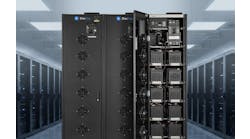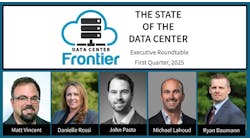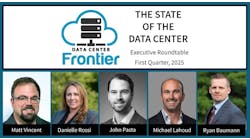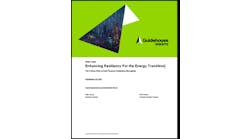Data Center Insights: Michael Lahoud, Stream Data Centers
The Data Center Frontier Executive Roundtable features insights from industry executives with lengthy experience in the data center industry.
Here’s a look at the Q1 2025 insights from Michael Lahoud, Co-Managing Partner, Stream Data Centers.
Michael Lahoud has dedicated his career to ensuring that technology meets the customer's needs. Joining Stream in 2011 as a technical complement to the partners’ real estate acumen, his experience in data center infrastructure has helped him guide the organization’s business strategies and technical go-to-market offerings ever since. His approach has cultivated unparalleled talent within Stream’s ranks and reinforced the company’s ability to deliver exceptional data center experiences through consistent action. A variety of roles at Stream (including seven years as Chief Operating Officer) have shaped Michael’s philosophy as a Co-Managing Partner. While his knack for community building, earning trust, and setting new performance standards was perfected in the workplace, these core commitments were forged on the field. As a former collegiate and current competitive goalkeeper, Michael brings an appreciation for teamwork and healthy competition into his role within the data center sphere. He is a member of multiple industry associations and an ongoing industry contributor. In business as in sports, Michael always makes decisions with an eye for what’s best for the whole team over the long term (but still, we all know better than to challenge him on the soccer field).
Power Infrastructure & Energy Resilience in 2025
Data Center Frontier: As power constraints intensify across key data center markets, how are industry leaders addressing energy security, backup power solutions, and the integration of alternative energy sources such as hydrogen, natural gas, and nuclear?
Michael Lahoud, Stream Data Centers: To achieve efficiency and reliability, all options are on the table for many industry players. Many see gas as a practical bridge, but nuclear is a long-term play that is being investigated as well. Ultimately, what’s used largely depends on the customer. The investments being made today in assorted energy methods will help serve the industry in the ~8-10 year range, but looking for sites in markets where grid capacity remains is the logical move right now. Those locations are hard to find, but they can be uncovered with smart due diligence processes.
Taking a step back, we see new 'data center developers' putting forth purely speculative development plans hoping they can get into the queue with utilities to decrease their own uncertainty. However, that’s also worsening the problem, making it difficult for utilities to get a handle on what’s real and what’s not. This further constrains access to power for everyone.
Establishing energy security long-term now means learning how we can be a good partner to utilities while creating clarity around when there’s real demand. Resilience and a strong power pipeline will depend as much on our ability to collaborate and create reciprocity within the energy ecosystem as it will on the power generation method itself.
Cooling Imperatives for Managing High-Density AI Workloads
Data Center Frontier: With the rapid rise of AI-driven workloads pushing power densities beyond traditional limits, what new cooling technologies and efficiency strategies are being deployed to maintain operational stability and sustainability?
Michael Lahoud, Stream Data Centers: For the past two years, Stream Data Centers has been developing a modular, configurable air and liquid cooling system that can handle the highest densities in both mediums. Based on our collaboration with customers, we see a future that still requires both cooling mediums, but with the flexibility to deploy either type as the IT stack destined for that space demands.
With this necessity as a backdrop, we saw a need to develop a scalable mix-n-match front-end thermal solution that gives us the ability to late bind the equipment we need to meet our customers’ changing cooling needs. It’s well understood that liquid far outperforms air in its ability to transport heat, but further to this, with the right IT configuration, cooling fluid temperatures can also be raised, and this affords operators the ability to use economization for a greater number of hours a year. These key properties can help reduce the energy needed for the mechanical part of a data center’s operations substantially.
It should also be noted that as servers are redesigned for liquid cooling and the onboard server fans get removed or reduced in quantity, more of the critical power delivered to the server is being used for compute. This means that liquid cooling also drives an improvement in overall compute productivity despite not being noted in facility PUE metrics. Counter to air cooling, liquid cooling certainly has some added management challenges related to fluid cleanliness, concurrent maintainability and resiliency/redundancy, but once those are accounted for, the clusters become stable, efficient and more sustainable with improved overall productivity.
Site Selection & Market Evolution in a Constrained Environment
Data Center Frontier: Given ongoing challenges in land acquisition, power availability, and local regulatory hurdles, how are data center operators refining their site selection strategies in Q1 2025? Which North American markets are emerging as the next hotspots for development?
Michael Lahoud, Stream Data Centers: Yes, site selection is getting harder. Many good sites have already been absorbed, and it's difficult to know where there is still available capacity and where new load can be served. Utilities are overwhelmed by increasing demand, and interconnection queues are so long and overcrowded that they can’t possibly serve more than a small fraction of the load being requested by developers and end users. One common strategy has been to go where there is still power left, and we’re now seeing hyperscalers expanding beyond Northern Virgina into central/rural Virginia, for example. Some hyperscalers have entered non-traditional data center markets in Indiana or Mississippi where there was available capacity, among other rural areas in the central U.S.
This kind of market will make many developers shy about sharing where they’re headed next, but what Stream can say is that there are certainly still pockets of available grid capacity out there that can and will suit the next AI/hyperscale-capable site. Having a great location strategy team and process makes the haystack easier to sift through and the needle easier to spot, so we’ve spent a lot of time finding the best methodology that is now supporting us well in our development efforts. Going forward, everyone – customers, developers, investors – should expect timelines to be a bit more drawn out as space becomes more difficult to find.
The Changing Economics of Data Center Development
Data Center Frontier: With rising construction costs, supply chain challenges, and shifting enterprise demands, how are data center providers, energy specialists, and real estate firms adapting their business models to sustain growth and profitability in 2025?
Michael Lahoud, Stream Data Centers: Focusing on long-term and deep partnerships with the best vendors, creating OFCI (owner furnished contractor installed)-based processes and designing and building around configurable systems allows for added flexibility and replicability - without affecting long-lead equipment or precision results for hyperscale customers.
Still, utility commitments are another factor here. To help utilities identify real demand, developers and customers must often cover the upfront costs of power interconnection while also committing to minimum power usage fees for 10+ years.
This will require significant capital and long-term commitment, and it’s going to become harder to buy down lead time and stay in the interconnection queue while working with customers to land a lease and get their commitment to the power ramp. This new world order favors those with deep pockets, strong financial partners and firms that are able/willing to take some financial risks to secure power. But on a deeper level, this all underlines the fact that trust, transparency and a strong track record of development will be crucial for data center providers that want to keep (and deepen) their relationships with investors and customers.
As the stakes get higher, betting on the right partnerships will matter even more. Developers that act with integrity while making development less uncertain and more secure for their partners will be the ones that make it.

Matt Vincent
A B2B technology journalist and editor with more than two decades of experience, Matt Vincent is Editor in Chief of Data Center Frontier.






